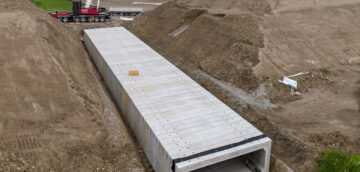Sewer pipes not only function as a conduit to transport stormwater or wastewater, but they must also have the load-carrying capacity for whatever is built above them. One fundamental difference between a rigid pipe, like concrete, versus a flexible pipe, like plastic pipe or corrugated steel, is that a concrete pipe can be reinforced to accommodate any loading condition, while the flexible pipe’s structural strength is provided by the pipe-soil interaction that must be properly constructed by the pipe installer. In other words, flexible pipe is much more installation-sensitive because it relies completely on the soil envelope for its structural strength.
Design engineers and contractors both have a legal responsibility to provide a safe and healthy workplace on construction projects. One potential problem with the traditional “design-bid-build” model is that it breeds a “cheaper is better” mentality among both design engineers and contractors. This leads to design engineers focused on specifying designs with the lowest initial cost to build it, and contractors that are focused on productivity on the jobsite. Also, this typically results in the low bidder of a tender to be selected and increases the risk of compromising the quality of construction.
RELATED: Why Concrete Pipe Was Solely Specified for Ministry Of Transportation Project
An unstable trench can collapse, killing or seriously injuring workers. One of the requirements under Ontario’s Occupational Health and Safety Act and Regulations for Construction Projects (OHSA O.Reg. 213/91) is to identify the types of soil and determine the methods to be used to protect workers from cave-ins. The soil type in which an excavation is made should be classified as defined in OHSA O.Reg. 213/91, s. 226 where there are four general types of soil: Type 1 or 2 – good, stable soils, Type 3 – fairly good soil, and Type 4 – poor soil that is very soft and unable to support itself. In a single trench, soil properties can vary widely from top to bottom or along its length. Even hard, stable soil may contain faults in seams or layers that make it unstable when excavated. If an excavation contains more than one type of soil, the soil should be classified as the type with the highest number.
Three basic methods can protect workers against trench or excavation cave-ins:
• Sloping – cutting back the trench wall at an angle inclined away from the excavation as prescribed in OHSA O.Reg. 213/91, s. 234;
• Shoring – timber or hydraulic support systems for trench or excavation walls to prevent movement of soils, underground utilities, roadways and foundations;
• Prefabricated support systems such as trench boxes and shields.
It’s important to note that both shoring systems and trench boxes must be designed by a professional engineer.
Trench boxes
Trench boxes are only meant to protect workers by providing a temporary safe working area for installing pipe. OHSA O.Reg. 213/91, s. 235 requires a trench box be designed for a specific location or project if the trench depth exceeds six metres or the trench width exceeds 3.6 metres. Similar to the OHSA requirements for sloping a trench wall, trench boxes are required to be placed directly on the trench bottom in Type 3 & 4 soil conditions. For Type 1 & 2 soil conditions only, some trench boxes could be designed to be hung-up to a maximum of 900mm (36 inches) from the bottom of the trench. However a 300mm (12 inch) wide ledge must be provided to support the trench box, plus doing this will significantly reduce the actual capacity (allowable depth) of the trench box.
Flexible Pipe Industry’s Recommendations
There are several references that design engineers specifying plastic pipe must know:
• CSA B182.11 – Standard Practice for the Installation of Thermoplastic Drain, Storm, and Sewer Pipe and Fittings;
• ASTM D2321 – Standard Practice for Underground Installation of Thermoplastic Pipe for Sewers and Other Gravity-Flow Applications;
• Plastic Pipe Institute Handbook of Polyethylene Pipe;
• Uni-Bell Handbook of PVC Pipe.
All of the above documents cover installation of plastic pipe and outline similar recommendations regarding the use of trench boxes. Here are a few highlights from these various sources:
• “When using movable trench supports, the pipe location, jointing, and its embedment shall be not disturbed. This can be accomplished by limiting the use of standard movable trench boxes that are in excess of 2.5 pipe diameters on either side of the pipe to below the top of the pipe or to a shelf above the top of the pipe.” – CSA B182.11, cl. 5.2.5.2
• “Movable supports should not be used below the top of the pipe zone unless approved methods are used for maintaining the integrity of embedment material. Before moving supports, place and compact embedment to sufficient depths to ensure protection of the pipe. As supports are moved, finish placing and compacting embedment.” –
ASTM D2321, cl. 6.4.2
• “In order to use the shield with PE pipe, all excavation of the trench below the pipe crown elevation should be done from inside of the shield. That is, the backhoe operator should dig inside of the shield and force the shield down as soil is removed.
(The technique of digging out a large hole to pipe invert grade then sliding the shield into it will result in excess deflection of PE pipe and therefore, should not be used.) After placing the pipe in the trench, embedment material should be placed in lifts and the shield vertically raised after each lift is placed so that workers can shovel embedment material under the shield to fill the void created by the shield wall.” – PPI Handbook of PE Pipe
It would be very interesting to see how these last two points could be accomplished while observing the OHSA requirements because they require the worker to be inside the trench box while it is being moved, or the worker must enter an excavation that is no longer being protected by a trench box.
Conclusion
Based on these recommendations by the plastic pipe industry, the best case scenario for a plastic pipe would be installation in a Type 1 soil condition using a trench box designed to sit on a ledge 900mm above the trench bottom. Accounting for the minimum 150mm bedding below the pipe and the embedment extending a minimum 300mm above the pipe as per Ontario Provincial Standards; the maximum pipe size that works for this configuration is a 450mm diameter plastic pipe. Again this is the best case scenario for a situation requiring a trench box.
Proper construction practices with trench boxes that adhere to OHSA requirements may conflict with the plastic pipe industry’s recommendations. Pipe designers should be aware that it’s not viable to properly install large plastic pipe (greater than 450mm) without compromising the pipe embedment or the Occupational Health and Safety Act. Hopefully it’s clear to everyone which one of these takes precedence; worker safety is paramount!

McGee Street in Pembroke, Ontario is a 1.1 km residential street that runs next to ...

WSP Canada Inc. (WSP) was retained by the City of Toronto to undertake the preliminary ...

The Regional Municipality of York (located north of Toronto, Ontario) is investing in building a ...
